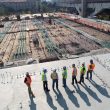Local governments move forward with livable transit
Long commutes, urban sprawl, fuel costs, environmental issues and a down economy are causing government at all levels to consider transit as a transportation option that affects more than just commute times. While the federal government is beginning to provide more funding for “livable” transit, cities and counties are focusing on transit infrastructure as critical components of live-work-play developments.
For the past few years, Fresno and Fresno County, Calif., have been focusing on increasing Transit Oriented Development (TOD) in the area, including developing a bus master transit plan and planning a high-speed rail station downtown. “There’s a lot of energy behind it,” says John Downs, Fresno County’s planning manager. “The masses are becoming more interested in what we are talking about.”
To encourage enthusiasm for TODs, the city recently used $50,000 from a state grant to host a three-part workshop series, “Making Transit Oriented Development a Reality in the San Joaquin Valley,” that brought together public officials, developers, architects and planners. “We were able to introduce concepts to local developers and have people who have been successful with TOD bring it to the local folks and make a connection between Fresno and other places,” Downs says. The workshop also included a design competition for TOD projects at two different sites, allowing people to see what TOD could look like in Fresno, says Bonique Salinas, a planner with the Fresno Planning and Development Department.
The federal government recently awarded St. Louis nearly $25 million as part of the Urban Circulator Program for the St. Louis Loop Trolley Project. The funding, however, does not automatically ensure the project’s success. “We still have a long way to go,” says Thomas Shrout, executive director of locally based Citizens for Modern Transit, a non-profit involved in the project. With the total cost estimated at $44 million, stakeholders are securing funding from a combination of transportation development districts, tax increment financing, new market tax credits and about $5 million in philanthropic contributions.
The project fits into the federal government’s recently announced preference for funding livable transit projects by looking at ways to improve the community as a whole, as well as decreasing commute times. Officials plan to make use of existing MetroLink stations and connect popular destinations with neighborhoods that are in transition phases to foster continued development. Stops will include Delmar, named one of the American Planning Association’s “10 Greatest Streets in America” in 2007. The electric trolley cars also will provide environmental benefits by reducing gas consumption, Shrout says. “We thought this project was right up the administration’s alley,” he says.



















